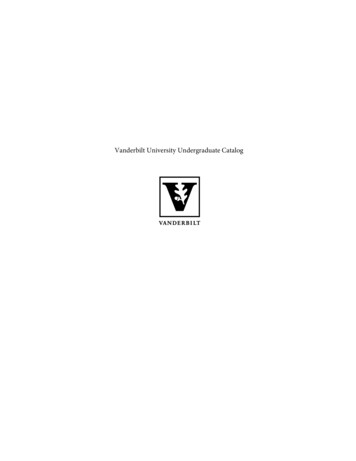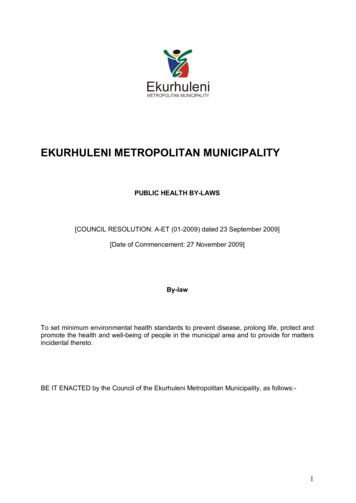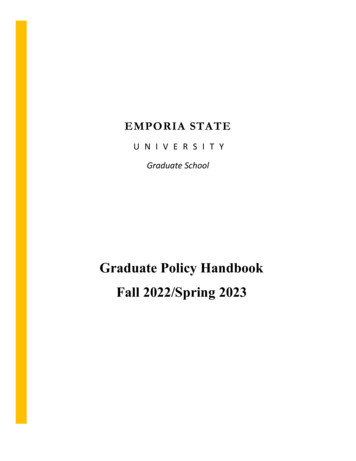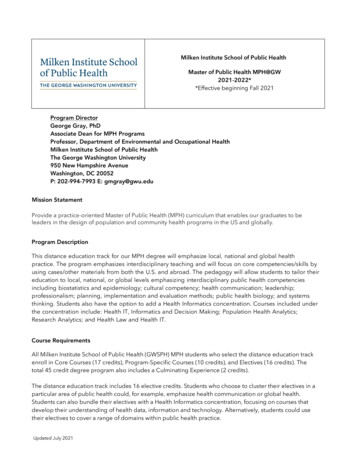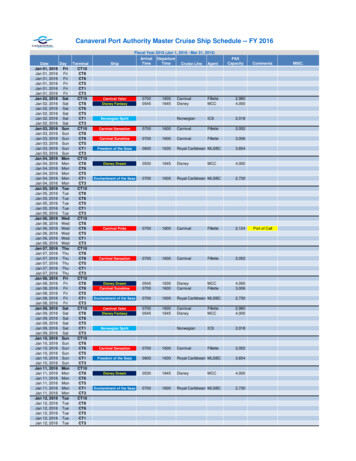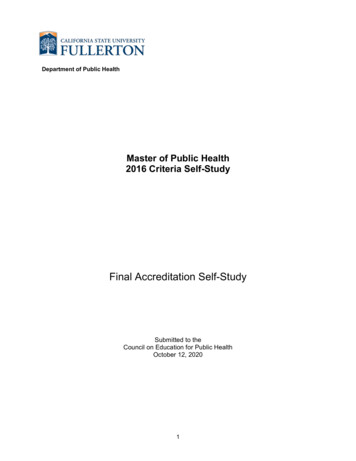
Transcription
Department of Public HealthMaster of Public Health2016 Criteria Self-StudyFinal Accreditation Self-StudySubmitted to theCouncil on Education for Public HealthOctober 12, 20201
Table of ContentsIntroduction . 4A1. Organization and Administrative Processes . 14A2. Multi-Partner Programs . 19A3. Student Engagement . 20A4. Autonomy for Schools of Public Health . 22A5. Degree Offerings in Schools of Public Health . 23B1. Guiding Statements . 24B2. Graduation Rates . 26B3. Post-Graduation Outcomes . 28B4. Alumni Perceptions of Curricular Effectiveness . 29B5. Defining Evaluation Practices . 29B6. Use of Evaluation Data . 33C1. Fiscal Resources . 35C2. Faculty Resources . 39C3. Staff and Other Personnel Resources . 42C4. Physical Resources . 43C5. Information and Technology Resources . 45D1. MPH & DrPH Foundational Public Health Knowledge . 48D2. MPH Foundational Competencies . 50D3. DrPH Foundational Competencies . 55D4. MPH & DrPH Concentration Competencies . 56D5. MPH Applied Practice Experiences . 64D6. DrPH Applied Practice Experience . 64D7. MPH Integrative Learning Experience . 67D8. DrPH Integrative Learning Experience . 69D9. Public Health Bachelor’s Degree General Curriculum . 70D10. Public Health Bachelor’s Degree Foundational Domains . 71D11. Public Health Bachelor’s Degree Foundational Competencies . 72D12. Public Health Bachelor’s Degree Cumulative and Experiential Activities. 73D13. Public Health Bachelor’s Degree Cross-Cutting Concepts and Experiences . 74D14. MPH Program Length . 752
D15. DrPH Program Length . 76D16. Bachelor’s Degree Program Length. 77D17. Academic Public Health Master’s Degrees . 78D18. Academic Public Health Doctoral Degrees . 79D19. All Remaining Degrees . 80D20. Distance Education . 81E1. Faculty Alignment with Degrees Offered . 82E2. Integration of Faculty with Practice Experience . 86E3. Faculty Instructional Effectiveness . 88E4. Faculty Scholarship. 91E5. Faculty Extramural Service . 96F1. Community Involvement in Program Evaluation and Assessment . 98F2. Student Involvement in Community and Professional Service . 103F3. Assessment of the Community’s Professional Development Needs . 104F4. Delivery of Professional Development Opportunities for the Workforce . 106G1. Diversity and Cultural Competence . 107H1. Academic Advising . 113H2. Career Advising . 116H3. Student Complaint Procedures . 118H4. Student Recruitment and Admissions . 120H5. Publication of Educational Offerings . 1233
LIST OF ican Language ProgramAssociation for Psychological ScienceApplied Practice ExperiencesAmerican Public Health AssociationAuxiliary Services CorporationAcademic YearCommunity Advisory BoardCenters for Disease Control and PreventionContinuing Education UnitsCouncil on Education for Public HealthCalifornia Faculty AssociationCertified Health Education SpecialistCollege of Health and Human DevelopmentCenter for Internships and Community EngagementCertified Industrial HygienistCumulative Index to Nursing and Allied Health LiteratureCenter and Institute Planning and Expansion ProgramCalifornian Journal of Health PromotionCalifornia Faculty AssociationChief Financial OfficerContent Management SystemDepartment of CommunicationsCalifornia Post-Secondary Education CommissionCertified in Public HealthCalifornia State University, Fullerton Philanthropic FoundationCalifornia School of Professional PsychologyCalifornia State UniversityCalifornia State University, FullertonCalifornia State University, Long BeachCurriculum VitaeDiversity, Inclusion & Equity ProgramsDepartment Personnel StandardsDoctorate in Public AdministrationDoctorate in Public HealthEducation ClassroomElectronic Core CollectionEnvironmental and Occupational Health and SafetyEta Sigma GammaElizabeth Stewart Hands and Associates Food Processor NutritionalAnalysis SoftwareEnhancing Postbaccalaureate Opportunities at Cal State Fullerton forHispanic Students4
LIST OF ABBREVIATIONS MHRT:MiFi:MPH:MPP:MS:MSW:NCHEC:NCI:NGO:Electronic Resource FileFrequently Asked QuestionsFaculty Affairs and RecordsFaculty Development CenterFederal Emergency Management AgencyFull-time Equivalent FacultyFull-time EquivalentFull-time Equivalent StudentsFiscal YearGerontological HealthGraduation InitiativeGrade Point AverageGraduate Record ExaminationGraduate StudiesHead CountDepartment of Health Science(College of) Health and Human DevelopmentHealth Promotion and Disease PreventionHealth Promotion Research InstituteHuman ResourcesHealth Resources and Services AdministrationIndirect CostsIntegrative Learning ExperienceInstitutional Review BoardInformation TechnologyKinesiology and Health ScienceDepartment of KinesiologyLicensed Clinical Social WorkerLesbian, Gay, Bisexual, TransgenderLearning Management SystemMasters of Business AdministrationMaster Certified Health Education SpecialistMission and Goals InitiativeMinority Health and Health Disparities Research Training ProgramMobile WiFiMaster of Public HealthMaster of Public PolicyMicrosoftMasters of Social WorkNational Commission for Health Education CredentialingNational Cancer InstituteNon-governmental organization5
LIST OF ABBREVIATIONS :USC:USDA:VP:VPAA:WASC:WSCUC:National Institutes of HealthNon-profit organizationOrange County Health Care AgencyOffice of Grants and ContractsOffice of Information TechnologyOffice of Research DevelopmentPrincipal InvestigatorPrimary Instructional FacultyPublic HealthDepartment of Political ScienceUniversity Planning, Resource and Budget CommitteeRandom Access MemoryRegistered Environmental Health SpecialistResearch, Scholarly, and Creative Activities Grant ProgramRegistered NurseRetention, Tenure and PromotionScience Applications International CorporationStatistical Analysis SystemSan Diego State UniversityStudent/Faculty RatiosStudent Opinion QuestionnairesIBM Statistical Product and Service SolutionsStrengths, Weakness, Opportunities, ThreatsTest of English as a Foreign LanguageUniversity AdvancementUniversity of California, IrvineUniversity of California, Los AngelesUniversity of California, San DiegoUniversity of Illinois, ChicagoUniversity Learning CenterUniversity of North CarolinaUniversity Policy StatementUniversity of Southern CaliforniaUnited States Department of AgricultureVice PresidentProvost/Vice-President for Academic AffairsWestern Association of Schools and CollegesWestern Association of Schools and Colleges Senior College andUniversity Commission6
Introduction1) Describe the institutional environment, which includes the following:a. year institution was established and its type (e.g., private, public, land-grant, etc.)California State University, Fullerton (CSUF) was founded in 1957 as a comprehensive state university.As part of the 23-campus California State University (CSU) system, CSUF is subject to policiesestablished by the California Legislature and the CSU Board of Trustees. Governance at the campuslevel is the responsibility of the President (Framroze Virjee, JD). CSUF is fully accredited by the WesternAssociation of Schools and Colleges Senior College and University Commission (WSCUC); nationallyaccredited in art athletic training, business, chemistry, communications, communicative disorders,computer science, dance, engineering, music, nursing, public administration, public health, social work,teacher education and theater.b. number of schools and colleges at the institution and the number of degrees offered by theinstitution at each level (bachelor’s, master’s, doctoral and professional preparation degrees)California State University, Fullerton offers 110 degree programs – 55 undergraduate and 55 graduate –including a doctorate in education and doctor in nursing practice. The academic programs are housedwithin 8 colleges: Arts; Business and Economics; Communications; Education; Engineering andComputer Science; Health and Human Development; Humanities and Social Sciences; Natural Sciencesand Mathematics. Degree programs at CSUF include: Bachelor of Arts (36), Bachelor of Fine Arts (2),Bachelor of Music, Bachelor of Science (16), Master of Arts (18), Master of Business Administration,Master of Fine Arts (3), Master of Music, Master of Public Administration, Master of Public Health, Masterof Science (27), Master of Social Work, Doctor of Education, and Doctor of Nursing Practice. CSUF offerscertificate programs that are designed to help individuals advance or change career paths by providing anin-demand skill set. Certificate programs are offered for different fields of work: Business (8); Crime andForensics (3); Fiduciary Management (2); Technology and Engineering (6); and Human ResourcesManagement. Programs for educators are also offered at CSUF, and include: Teacher InductionProgram, Clear Education Specialist Credential, Single Subject Credential Prerequisites, Prerequisites forSpecial Education Preliminary Credential Program, Autism Added Authorization, and PostsecondaryLiteracy and Learning Certificate.c.number of university faculty, staff and studentsIn Fall 2019, there were 39,868 students enrolled including 1,579 international students from 77 nations.Over half of the students were female (57.5%) and the student body is racially/ethnically diverse (Asian20.5%, Black/African American 2.0%, Hispanic/Latinx 43.8%, International* 7.1%, Multi-Race 3.9%,Native American .1%, Pacific Islander .2%, White 19.3%, and Unknown 3.2%. The university has over4,000 full- and part-time faculty (2,305 instructional faculty and 73 non-instructional faculty) and staffmembers.d. brief statement of distinguishing university facts and characteristicsIn the US News & World Report (2019), CSUF ranked as number 3 on the “Top Public School” list andranked among the top regional universities of the West that offer a full range of undergraduate majors,plus master’s and some doctoral programs. Diverse Issues in Higher Education (2019) ranks CSUF 2nd inthe nation in the number of baccalaureate degrees awarded to minority students, based on data from theU.S. Department of Education. CSUF is 3rd in California and 5th in the nation in awarding baccalaureatedegrees to Hispanic students. Among Asian-American students, it ranks 11th nationally for the number ofbachelor’s degrees and 8th in the state for both bachelor’s and master’s degrees awarded. Money ranksCSUF in the Top 3% of “Best Colleges for Your Money” (2019) and Forbes ranks CSUF among top U.S.institutions for “Best Value.” (2019)7
As of May 2020, more than 302,670 students have graduated from CSUF in 55 undergraduate degreesand 55 graduate degrees, including a Doctorate in Education and Doctor of Nursing Practice. CSUF is theonly CSU located in Orange County, and most students live in Orange County and were educated atCalifornia schools and junior colleges.Faculty members were awarded 31.5 million in grants and contracts for research and scholarly activitiesin 2019-20. A 2017 economic impact analysis shows that CSUF is a major driver of economic activitystatewide, powering 2.26 billion in economic activity, supporting more than 15,000 jobs and generating 126 million in local and state tax revenue. The bulk of that impact is felt in Orange and Los Angelescounties. In addition, CSUF returns 13.40 to California’s economy for every dollar invested by the state.e. names of all accrediting bodies (other than CEPH) to which the institution responds. The list mustinclude the regional accreditor for the university as well as all specialized accreditors to which anyschool, college or other organizational unit at the university respondsCalifornia State University, Fullerton was initially accredited by Western Association of Schools andColleges (WASC) –WSCUC in 1961. The most recent WSCUC review took place in 2019, which grantedCSUF reaffirmation for a full and maximum 10-year period. Individual programs maintain separateaccreditations from the following: National Association of Schools of Art and Design; National Associationof Schools of Dance; National Association of Schools of Music; National Association of Schools ofTheatre; Association to Advance Collegiate Schools of Business; Council on Academic Accreditation inAudiology and Speech-Language Pathology; Accrediting Council on Education in Journalism and MassCommunications; Public Relations Society of America; National Council for Accreditation of TeacherEducation; Accreditation Board for Engineering and Technology; ArbNet Arboretum AccreditationProgram; Council for Accreditation of Counseling and Related Educational Programs; Council forStandards in Human Services Education; Commission on the Accreditation of Athletic Training Education;Commission on Collegiate Nursing Education; Council on Education for Public Health; Council on SocialWork Education; Network of Schools of Public Policy, Affairs, and Administration; American ChemicalSociety; American Association of Nurse Anesthetists; American College of Nurse Midwives; CaliforniaBoard of Registered Nursing; and California Commission on Teacher Credentialing.f.brief history and evolution of the public health program (PHP) and related organizational elements,if applicable (eg, date founded, educational focus, other degrees offered, rationale for offeringpublic health education in unit, etc.)The Department of Public Health (formerly called Health Science) was founded in 2005. Prior to this date,CSUF had a Health Science minor housed in the Department of Kinesiology. The rise in Health Scienceminors, combined with demand in the field of public health and allied health, lead to the creation of thedepartment. Three concentrations were formed based on faculty expertise and research areas.From 2013 - 2019, the MPH program and the Department underwent numerous changes. In addition torevising curriculum to meet the 2016 Accreditation Criteria, the Department experienced a tremendousamount of growth and transitions, including the renaming of the Department to “Public Health”, with revisedundergraduate programs (approved, 2019). The number of faculty approximately doubled and there weresignificant changes in administration and leadership. The MPH Administrative Support person, who hadbeen with the program from its inception, retired. Subsequently, the position has had 3 different people, insuccession, assume the role. Three (former) Department Chairs have left the University - two werepromoted to leadership positions at other universities and one faculty retired. The summer that Dr. Woodtransitioned to Department Chair was bookended by sabbaticals of the former (Dr. Gill) and the current (Dr.Yang) MPH Program Advisor. As a consequence, the department suffered a loss of institutional memoryand delays in efforts to adopt and implement accreditation requirements.Though these unforeseen events have been challenging, the current department leadership has learnedfrom the experiences and is working collaboratively to create systematic and institutionalized processesand procedures that are less reliant on individual faculty and are more embedded within the department.8
The Department of Public Health is part of the College of Health and Human Development (CHHD).CHHD is among the most popular and fastest growing colleges in the University, led by Dr. LaurieRoades who was appointed Dean in January 2016. The mission of the College of Health and HumanDevelopment is to provide exemplary education, research, and community outreach related to humanhealth, development, and lifelong well-being. Emphasis is placed on both theory and evidence-basedpractice, with special attention to the development of critical thinking, leadership, and professional skillsneeded in a global society. The ethnic distribution of the CHHD student body is 46.4% Hispanic, 22.7%Asian/Pacific Islander, 17.7% White, 4% Multi-Race, 3.6% International, 3.3% Unknown, 2.2% Black, and0.1% American Indian (2018). CHHD includes 8 academic divisions: Child and Adolescent Studies;Counseling; Human Services; Kinesiology; Public Health; Nursing; Social Work; and Military ScienceProgram. The College also houses 14 Institutes and Centers in support of its mission: Center for Autism;Center for Boys and Men; Center for Cancer Disparities Research; Center for Community Collaboration;Center for Healthy Neighborhoods; Center for Nursing Workforce Excellence; The Center forSociocultural Sport and Olympic Research; Center for Sport Performance; Center for Successful Aging;Center for the Promotion of Healthy Lifestyles and Obesity Prevention; Employee Wellness Center; FallPrevention Center for Excellence; Fibromyalgia and Chronic Pain Center; and Health PromotionResearch Institute.2) Organizational charts that clearly depict the following related to the program:a. the program’s internal organization, including the reporting lines to the dean/director9
b. the relationship between program and other academic units within the institution. Ensure that thechart depicts all other academic offerings housed in the same organizational unit as the program.Organizational charts may include committee structure organization and reporting lines10
c.the lines of authority from the program’s leader to the institution’s chief executive officer (president,chancellor, etc.), including intermediate levels (e.g., reporting to the president through the provost)PresidentFramroze VirjeeVice Presidentfor InformationTechnologyVice President forAdministrationand Finance/CFOAmir H. DabirianDanny C. KimVice President forStudent AffairsProvost and VicePresident forAcademic AffairsVice Presidentfor UniversityAdvancementCarolyn C. ThomasGregory J. SaksHarry Le GrandeCSUF’s administrative organization. The figure above displays CSUF’s administrative organization,including key administrative positions. The University is administered by the President and by the heads offive divisions: Academic Affairs, Administration and Finance, Information Technology, Student Affairs, andUniversity Advancement.11
CSUF’s administrative organization, continued. The figure above displays the organization of AcademicAffairs and the various colleges in the University. The Provost/Vice President for Academic Affairs isCarolyn Thomas. The academic programs are housed within eight colleges: Arts; Business and Economics;12
Communications; Education; Engineering and Computer Science; Health and Human Development;Humanities and Social Sciences; Natural Sciences and Mathematics.A copy of all organizational charts are included in the ERF (ERF INTRO)d. for multi-partner programs (as defined in Criterion A2), organizational charts must depict allparticipating institutionsNot applicable.3) An instructional matrix presenting all of the program’s degree programs and concentrationsincluding bachelor’s, master’s and doctoral degrees, as appropriate. Present data in the formatof Template Intro-1.Instructional Matrix ‐ Degrees and ConcentrationsCampusbasedMaster's DegreesConcentrationHealth Promotion and Disease PreventionEnvironmental and Occupational Health and SafetyGerontological cutive DistancebasedMPHMPHMPH4) Enrollment data for all of the program’s degree programs, including bachelor’s, master’s anddoctoral degrees, in the format of Template Intro-2.DegreeCurrent Enrollment(2020‐2021)Master'sMPHHealth Promotion and Disease PreventionEnvironmental and Occupational Health and SafetyGerontological Health13536160
A1. Organization and Administrative ProcessesThe program demonstrates effective administrative processes that are sufficient to affirm its abilityto fulfill its mission and goals and to conform to the conditions for accreditation.The program establishes appropriate decision-making structures for all significant functions anddesignates appropriate committees or individuals for decision making and implementation.The program ensures that faculty (including full-time and part-time faculty) regularly interact withtheir colleagues and are engaged in ways that benefit the instructional program (e.g., participatingin instructional workshops, engaging in program specific curriculum development and oversight).1) List the program’s standing and significant ad hoc committees. For each, indicate the formula formembership (e.g., two appointed faculty members from each concentration) and list the currentmembers.MPH Program Committee: This standing committee meets once per month and is comprised of facultythat teach the core courses in the MPH Program, the MPH Admissions Committee chair, the MPH ILEcoordinator and other Department of Public Health faculty who wish to join. The committee is charged withinitiating, reviewing, and recommending all educational policies and curricula for the MPH Program;evaluating, recommending, and revising policies and procedures for admission to, progression andretention in, and graduation from the MPH Program; providing for a systematic review of the MPH Program,considering course and program evaluation outcomes, revision of the mission, philosophy and/or objectivesof the MPH Program; fostering, evaluating and maintaining accreditation standards; reviewing creativeopportunities to work with other schools and departments in the University to enrich public health researchand teaching in the MPH Program; recommending workshops and seminars for CHES/MCHES CEUs;reviewing MPH websites annually and make necessary changes; reviewing the catalog copy annually; andmaking necessary changes to the MPH Student Handbook. Committee Chair: Joshua Yang (current MPHProgram Advisor); Committee Members: Jordan Aquino, Shana Charles, Phillip Gedalanga (current MPHAdmissions Committee chair), Jasmeet Gill (past MPH Program Advisor), Portia Jackson Preston, MariaKoleilat, Alice Lee (past MPH Admissions Committee chair), Archana McEligot, Sinta McGee (MPHAdministrative Support), Bo Park, Jennifer Piazza, Mojgan Sami (ILE Coordinator), Michele Wood(Department Chair); and one Student Representative from each MPH cohort.MPH Admissions Committee: This standing committee meets approximately twice per semester tounderstand admission and enrollment policies for graduate programs at CSUF; develop strategies for usein the recruitment of MPH students; work with Sinta McGee (MPH Administrative Support) and DepartmentChair to develop and update admission criteria, processes and procedures; make admissionrecommendations to the Department Chair; update MPH view sheet. Committee Chair: Phillip Gedalanga;Committee Members: Jordan Aquino, Alice Lee, Tabashir Nobari, Pimbucha Rusmevichientong, and DianaTisnado; one MPH Student.MPH Assessment Committee: This standing committee reviews long-range plans for student enrollment,faculty recruitment, and financial planning in accordance with: (1) CEPH accreditation criteria, (2) CSUFregulations, and (3) Program’s mission, values, and goals. The committee meets approximately once permonth and is charged to evaluate all general academic and program policies, including student public healthcompetencies, class sizes, and field placement sites and culminating experience project; monitor, assess,evaluate, and submit an annual report on Program’s goals and measurable objectives and targetedoutcomes; at least once/year ask MPH primary faculty and other constituents to make recommendationsfor revisions to MPH policies and curriculum, core and track-specific competencies, as well as to the vision,mission, goals, and values of the Program; at least once/year meet with MPH Program Committee todiscuss any recommended necessary changes in curriculum, core and track-specific competencies, as wellas to the vision, mission, goals, and values of the Program; write and submit annual accreditation reportsto CEPH; plan, organize, and submit Preliminary Self-Study; meet with MPH graduates, MPH ProgramCommittee, and Community Advisory Board for input and review of Self-Study; submit Final Self-Study andother material outlined in the preliminary review report by the CEPH office. Committee Chair: Jasmeet Gill;14
Committee Members: Jordan Aquino, Shana Charles, Sinta McGee (Administrative Support), Bo Park,Jennifer Piazza, Mojgan Sami (ILE Coordinator), and Joshua Yang (MPH Program Advisor).MPH Comprehensive Exam Committee: This standing committee consists of two faculty from each trackand a committee chair who facilitates the exam. This committee meets approximately twice per year to planfor the implementation of the comprehensive exam, which occurs during week 13 of each semester. Thiscommittee is charged with developing exam questions and format, proctoring portions of the exam, scoringthe exams, and making recommendations for improving exam procedures. The committee is comprised ofPimbucha Rusmevichientong (Committee Chair, Facilitator of the Comprehensive Exam, and Writer of theStatistics and Research Methods questions), Jasmeet Gill and Alice Lee (Epidemiology questions), PortiaJackson Preston and Joshua Yang (Health Behavior Theory questions), Diana Tisnado and Jennifer Piazza(Gerontological Health questions), and Phillip Gedalanga and Bo Park (Environmental and OccupationalHealth and Safety questions). The take-home portion of the exam is constructed by the MPH ProgramAdvisor with input from current MPH instructors.2) Briefly describe which committee(s) or other responsible parties make decisions on each of thefollowing areas and how the decisions are made:A. degree requirementsMPH Program Committee and MPH Assessment Committee monitor degree requirements. TheAssessment Committee reports back on survey results (Current Student, Exit) and Community AdvisoryBoard comments. The Assessment Committee, along with the MPH Program Advisor, retaincommunication with CEPH and any change to degree requirements. These data and communications,taken together, inform degree requirements. If changes are needed, the MPH Assessment Committeepresents the proposed changes to the MPH Program Committee; this larger co
school, college or other organizational unit at the university responds California State University, Fullerton was initially accredited by Western Association of Schools and Colleges (WASC) -WSCUC in 1961. The most recent WSCUC review took place in 2019, which granted CSUF reaffirmation for a full and maximum 10-year period.


